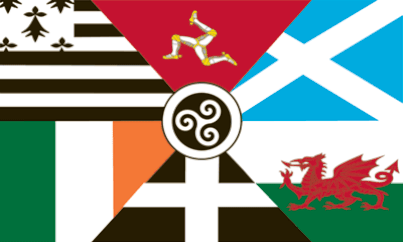Contemporary Celtic Culture and Politics
|
Pan-Celticism, sometimes called Celtic nationalism is a political, social and cultural movement that advocates solidarity and cooperation among Celtic nations and the Celtic diaspora. Some pan-Celtic organisations advocate for the creation of a federal state that unifies the Celtic nations. To do so would require Celtic regions to secede from their modern-day home nations including the the United Kingdom, Spain and France. Other Pan-Celtic organizations advocate for close cooperation among the Celtic nations as an expression of a coherent and homogeneous
national identity. These organization support movements of Breton, Cornish, Irish, Manx, Scottish and Welsh nationalism. The flag on the right is called The Celtic Flag or Celtic Collage. The flag contains elements from the flags of all six Celtic nations The symbol in the center of the flag is called the"triskelion". This ancient symbol is sometimes drawn as three spirals, or, in the case of the flag of the Isle of Man, it appears as three, bent human legs. The word derives from a Greek word meaning "three-legged". |
The triskelion dates back to the Neolithic Age. The earliest known example of the symbol was discovered on Malta and dates to roughly 4000 BCE. The symbol has been found on Celtic, Bronze age shields discovered in Brittany. The triskelion has been found the Newgrange mound, County Meath, Ireland and dates to about 3200 BCE. By the 5th Century CE the triskelion took on new meaning as a symbol of the Trinity in Celtic-based Christianity. In Brittany the symbol is called the "Triskèle". On the Isle of Man the tiskelion is call the "Tree Cassyn Vannin".The triskelion is at the center of the seal of the U.S. Department of Transportation
These links are a starting point for those who wish to explore Pan-Celticism or Celtic Nationalism:
TransCeltic
https://www.transceltic.com/
This is an excellent for information about all things Celtic. From food to festivals and myth to travel information, TransCeltic is a marvelous resource.
Celtic Congress
https://internationalcelticcongress.org/en/
“The International Celtic Congress was founded in 1902 in order to promote the knowledge, use, and appreciation of the languages and cultures of the six Celtic countries. National Branches of the Congress meet in an International Congress each year in order to help further these aims.”
The Celtic League
https://www.celticleague.net/
“The Celtic League is an inter-Celtic organisation that campaigns for the political, language, cultural and social rights of the Celtic nations. It does this across a broad range of issues. It highlights human rights abuse, monitors military activity and focuses on political, socio-economic, environmental, language and cultural issues, which generally or specifically affect one or more of the Celtic countries in some way. The organisation also aims to further each of the Celtic nations right to independence and to promote the benefits of inter Celtic cooperation. Additionally, the League draws attention to matters that we believe bear a wider concern for the peoples of the Celtic countries.”
TransCeltic
https://www.transceltic.com/
This is an excellent for information about all things Celtic. From food to festivals and myth to travel information, TransCeltic is a marvelous resource.
Celtic Congress
https://internationalcelticcongress.org/en/
“The International Celtic Congress was founded in 1902 in order to promote the knowledge, use, and appreciation of the languages and cultures of the six Celtic countries. National Branches of the Congress meet in an International Congress each year in order to help further these aims.”
The Celtic League
https://www.celticleague.net/
“The Celtic League is an inter-Celtic organisation that campaigns for the political, language, cultural and social rights of the Celtic nations. It does this across a broad range of issues. It highlights human rights abuse, monitors military activity and focuses on political, socio-economic, environmental, language and cultural issues, which generally or specifically affect one or more of the Celtic countries in some way. The organisation also aims to further each of the Celtic nations right to independence and to promote the benefits of inter Celtic cooperation. Additionally, the League draws attention to matters that we believe bear a wider concern for the peoples of the Celtic countries.”
The Modern Celtic World by the Numbers
The file in the link below loads a PDF with a table showing population size, land area, and numbers of native speakers of a Celtic language within the seven Celtic Nations. Size comparisons are made with familiar cities and statues within the USA
The file in the link below loads a PDF with a table showing population size, land area, and numbers of native speakers of a Celtic language within the seven Celtic Nations. Size comparisons are made with familiar cities and statues within the USA
| modern_celtic_world_by_the_numbers.pdf | |
| File Size: | 43 kb |
| File Type: | |
